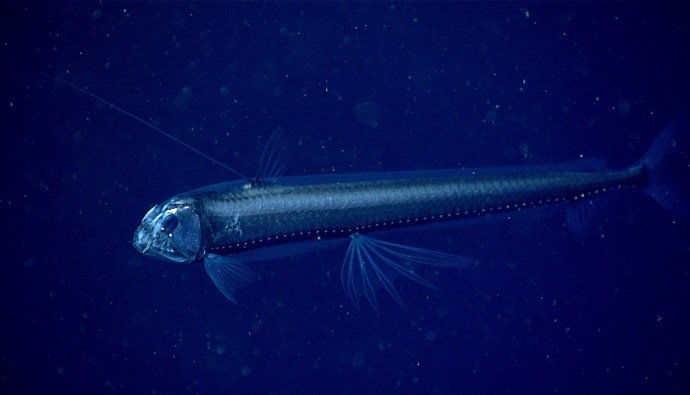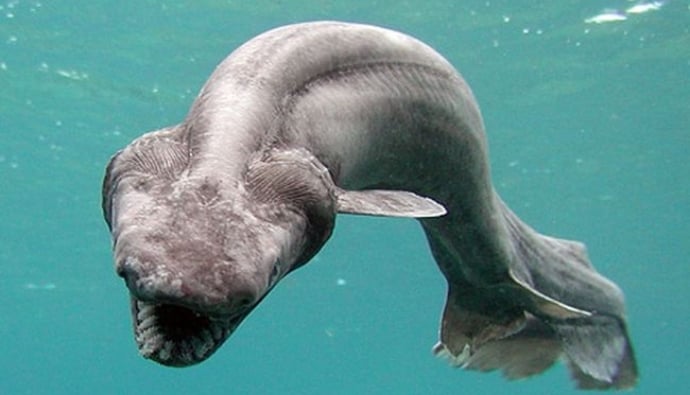There are all sorts of fish and creatures in the deep sea. Here, you’ll find fish in all kinds of colors and sizes. Some are huge while others can be scary.
If you’re curious about the scary fishes in the ocean, you’re in the right place. From the goblin shark to the frilled shark, we will learn about their looks, how they act, and where they live.
Ready? Let’s dive in!

What Makes a Fish Scary?
Here are a few things to make a fish scary.
Physical Appearance
First and foremost, most people would deem a fish scary with how it looks. An ugly fish or a scary fish often have long spikes, big teeth, huge eyes, or other strange shapes. But even with their scary appearance, people are often curious about these creatures.
Behavior and Aggression
Another factor that adds to a fish’s scary factor is its behavior. Is it known to eat other fishes? Does it have a reputation for being aggressive? People often get scared of fishes that hunt more than gentle and friendly fishes.
Potential Danger to Humans and Marine Life
Finally, scary fish can mean dangerous fish. There are a lot of fishes in the ocean and the deep sea that have poison, strong bites, or sharp teeth that can pose a danger to people and other species.
That’s why, in this guide, we’re going to learn about scary fishes so we’ll know how to protect ourselves and stay safe when exploring the sea.
Scary Fish Species
Anglerfish
First on our list is the anglerfish.
What makes this fish scary is its large rounded body, sharp teeth, and a peculiar flap that hangs from its head. The flap is a special fishing rod-like structure that acts as a luring mechanism.
Anglerfish usually live in the deep sea. They prefer dark, cold waters, where they can hide and wait for prey.
Anglerfish eat fish and hunt using a unique method. It uses the small, glowing light attached to its flap to attract curious fish and other marine animals. Whenever a prey comes close, the anglerfish opens its large mouth and swallows the prey whole.
Images and videos of anglerfish show how scary they can look.
They have wide, gaping, big mouths filled with razor-sharp teeth. Combine this with their eerie glowing lures, making them a sight to behold.
The anglerfish’s special way of hunting for food and frightening appearance makes it a scary fish. These mysterious deep-sea dwellers continue to fascinate and terrify those who learn about them.
Next time you think of scary fish, remember the anglerfish.
Goblin Shark
Second on our list is the goblin shark. It is a rare and mysterious species that inhabit the deep sea.
The goblin shark can be found at depths of 300 to 4,000 feet. They’re mostly found in the Pacific, Atlantic, and Indian Oceans.
The goblin shark has a very bizarre appearance – a protruding jaw, long and flattened snout, and sharp, needle-like teeth.
The protruding jaw can extend to capture unsuspecting prey. This unique feeding mechanism is known as “slingshot feeding.” It allows the goblin shark to project its jaw forward at lightning speed to snatch unsuspecting fish and squid from the water.
Images and videos of the goblin shark reveal its eerie appearance and peculiar feeding habits.
Its elongated snout, protruding jaw, and sharp teeth make it a frightening sight to behold. Observing the goblin shark in action, you’ll understand why the goblin shark is considered a scary fish.
The unusual appearance of the goblin shark and its remarkable feeding habits make it a worthy addition to our list of ugly fish and scary shark species.
Viperfish

The viperfish is another terrifying creature you should be aware of. It has a chilling appearance with its elongated, slender body and a large head filled with razor-sharp teeth.
Viperfish are found in deep sea waters all around the world at depths of 1,000 to 4,000 meters. The cold and dark is the perfect home for the viperfish. With its bioluminescent lure, it can attract unsuspecting prey easier.
The viperfish has one of the most unique and effective hunting strategies among other fishes.
This predatory fish possesses a bioluminescent organ known as a photophore located on a long dorsal spine. The photophore emits a soft, glowing light that lures in curious prey. Once the prey is within reach, the viperfish strikes quickly, using its long, sharp teeth to snatch and secure the meal.
Images and videos of the viperfish reveal a creature that appears otherworldly.
Large eyes, fearsome teeth, and eerie bioluminescent lure contribute to its intimidating reputation. As one of the scary sea monsters on the ocean floor, the viperfish is a true testament to the amazing adaptations of deep-sea species.
Frilled Shark

Emerging from the deep sea, the ancient frilled shark appears.
The frilled shark is a prehistoric-looking scary fish and one of the ocean’s most mysterious shark species. With its long body and eel-like appearance, it’s often called a “living fossil.” The primitive features of the frilled shark date back millions of years. Frilled sharks live in very deep waters, making them elusive and fascinating.
Their dark, snake-like bodies have rows of frilled gills.
These unique gill slits give the frilled shark its name. They stretch around its neck almost covering the whole of it. The mouth of the frilled shark has over 300 sharp, needle-like teeth, perfect for trapping prey. Frilled sharks hunt its prey and strike like a snake.
The frilled shark has a captivating and eerie appearance.
It swims slowly, with undulating body movements. Images and videos of the frilled shark reveal its ghostly features. They provide a glimpse into the depths where these ancient creatures hide.
Moray Eel

Moray eels love hiding in the cracks of the ocean floor.
You’ll often find them in rocky areas and coral reef. They look like a mix of a snake and a fish with their long, slender bodies and fins. They have small eyes and a powerful jaw with long, sharp teeth.
Moray eels are very shy despite their scary appearance.
Moray eels have an aggressive behavior. But mainly because they are only defending their territory. They hide in crevices and wait for their prey. And they’ll attack when they feel threatened.
They have very strong jaws.
Fun fact! They even have a second set of jaws, called the pharyngeal jaws, to grab and pull their prey. Their powerful bite can cause serious injury so it’s best to keep a safe distance whenever you see one.
Honorable Mentions
While the fishes above are terrifying, there are other creatures in the deep sea that deserve an honorable mention.
- Vampire Fish (Payara)
- Vampire Squid
- Ghost Shark
- Sea Lamprey
- Gulper Eel
- Mantis Shrimp
Safety Tips When Exploring the Ocean
Stay Cautious
Understand that the ocean is the habitat of different dangerous sea creatures. Humans are merely visitors so stay alert at all times and be mindful of your surroundings. Avoid touching marine life, and never provoke or disturb the creatures you encounter around the coral reef.
Research the area and its marine life before diving or swimming
Always check the area you’re planning on swimming or diving in.
Research and familiarize yourself with the marine life in the local area. This way, you can identify any potential hazards and avoid them. Learn what you can about the dos and dont’s and stay clear of dangerous marine life.
When you make an informed decision, your chances of surviving become higher.
Maintain a safe distance from unfamiliar or dangerous marine life
If you encounter a potentially dangerous fish, it’s best to keep your distance and avoid sudden movements. A lot of sea creatures attack if they feel threatened or cornered.
Only observe marine life from a safe distance. Don’t go too near.
Avoid wearing shiny jewelry or brightly colored clothing
Science proves that fish can see colors. When you wear shiny objects and bright colors, you alert them with your presence and even spook them. This is also the reason why fishermen choose shiny and colorful baits.
When exploring the sea, always wear neutral colors and remove jewelry to avoid unwanted attention from curious or aggressive fish.
Follow local guidelines and listen to the advice of experts.
Marine biologists and experienced divers can offer invaluable advice on how to stay safe. Pay attention to any posted signs or warnings, and always adhere to the recommendations of professionals.
By following these safety tips, you can enjoy the ocean’s wonders and decrease the risk of dangerous encounters.
First Aid and Emergency Response
Encountering venomous or toxic fish in the ocean can be a daunting experience. Knowing how to recognize the symptoms and respond appropriately is crucial for ensuring your safety. In this section, we will cover the steps to take in case of injury or envenomation and when to seek medical help.
Symptoms of venomous or toxic fish bites and stings can vary. The common signs include intense pain, swelling, redness, and sometimes nausea or difficulty breathing (1). In some cases, the affected area may become discolored or develop blisters. It’s essential to monitor the symptoms and act fast if they worsen.
If you are bitten or stung by a venomous fish, follow these steps:
- Remove yourself from the water and avoid moving the affected area to prevent the venom from spreading.
- Immerse the affected area in hot water (as hot as the person can tolerate without causing burns) for up to 90 minutes to help neutralize the venom.
- Take over-the-counter pain relievers to ease pain and inflammation.
- Keep the wound clean and dry to prevent infection.
Seek immediate medical assistance if the symptoms worsen or persist. This also includes difficulty breathing, chest pain, and severe swelling. In some cases, antivenom or additional treatment may be necessary.
Understand the symptoms of venomous or toxic fish bites and stings. This will help you know the appropriate first aid steps that can help ensure your safety. Always be cautious around unfamiliar marine life, and when in doubt, seek professional medical help.
Conclusion
In this article, we’ve explored the terrifying world of the ocean’s scariest fish species from the frilled shark to the goblin shark. Each one of these scary fish has its own set of unique and frightening features.
There is a lot of scary marine life under the deep sea. But even the ugliest fish and spooky species are important in maintaining the delicate balance of marine ecosystems.






 Facebook
Facebook YouTube
YouTube



